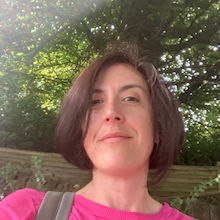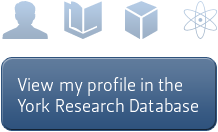Mary Fairclough
Visit Mary Fairclough's profile on the York Research Database to:
- See a full list of publications
- Browse activities and projects
- Explore connections, collaborators, related work and more
Profile
Biography
Mary joined the department 2012 as a Lecturer, and was promoted to Senior Lecturer in 2017 and Professor in 2021. She previously taught in the Department of English Language and Literature at the University of Huddersfield, and completed a Government of Canada Postdoctoral Fellowship at Carleton University, Ottawa. She completed her MA and PhD at the Centre for Eighteenth Century Studies and Department of English and Related Literature at York.
Her research and teaching interests lie in the intersection between literature, politics, science and religion in the long eighteenth-century. Her first book The Romantic Crowd: Sympathy, Controversy and Print Culture (Cambridge University Press, 2013) is a study of the representation of crowds in the Romantic period and the way in which sympathy is understood as the catalyst of collective behaviour. Her second book Literature, Electricity and Politics 1740-1840 (Palgrave, 2017) investigates the science and figurative language of electricity in late eighteenth-century and Romantic-period literary and political discourse.
In 2023-24 she held a Leverhulme Research Fellowship to complete her third book about Romantic period women writers and devotion, focusing on the print culture and book history of devotional writings, and the ways in which reading aloud produces devotional feeling. She is currently editing Mary Wollstonecraft’s The Female Reader for the forthcoming Oxford University Press edition of The Complete Works of Mary Wollstonecraft.
Mary is Treasurer of the British Association for Romantic Studies. She has organised conferences on literature and medicine, the works of Anna Letitia Barbauld, and the BARS 2017 International Conference Romantic Improvement.
Research
Overview
Mary is a member of the interdisciplinary Centre for Eighteenth Century Studies. Her research on late eighteenth-century and Romantic-period literature and culture has an interdisciplinary ethos, bringing together literary analysis with the study of affect and emotion, and the history of science, religion and politics. In addition to her three monographs she is the author of essays and articles on sympathetic communication, the politics of the picturesque, Romantic periodical print culture, the function of the optical telegraph, the imagination in late eighteenth-century scientific discourse, the Peterloo massacre, action at a distance in the work of P. B. Shelley, the science of chemistry in Frankenstein and its adaptations, Dissenting protestant educational and reading practices, and Della Cruscan poetry.
Her first monograph The Romantic Crowd: Sympathy, Controversy and Print Culture (Cambridge University Press, 2013) explores late eighteenth- and early nineteenth-century understandings of sympathy not just an emotional or imaginative phenomenon, but also as a physiological one, though which disorder in one part of the body is instantly communicated to another. The book explores how sympathy takes on contested significance during the British debate over the French Revolution, and during mass demonstrations for parliamentary reform in the 1810s. It investigates how writers like Mary Wollstonecraft, Helen Maria Williams, John Thelwall, William Hazlitt and Thomas De Quincey attempted to rehabilitate a language of sympathetic communication for their own political ends. The book was shortlisted for the BARS First Book Prize in 2015.
Mary’s second monograph Literature, Electricity and Politics 1740–1840:‘Electrick Communication Every Where’ (Palgrave, 2017) investigates the science of electricity in the long eighteenth century and its textual life in literary and political writings. Debates about the nature of electricity dovetailed with discussions of the relation between body and soul, the nature of sexual attraction, the properties of revolutionary communication and the mysteries of vitality. This book explores the complex textual manifestations of electricity between 1740 and 1840, in which commentators describe it both as a material force and as a purely figurative one. The book analyses attempts by both elite and popular practitioners of electricity to elucidate the mysteries of electricity, and traces the figurative uses of electrical language in the works of writers including Mary Robinson, Edmund Burke, Erasmus Darwin, John Thelwall, Mary Shelley and Richard Carlile. The book was shortlisted for the British Society for Literature and Science Book Prize in 2018.
Her latest book, provisionally titled Romantic Devotion 1772-1811: Voice, Praise, and Print Culture, was supported by a Leverhulme Research Fellowship 2023-24. It analyses devotion, understood both as a set of customs for Christian worship, and an affective state or feeling. The book focuses on the work of Anna Laetitia Barbauld, Mary Wollstonecraft and Mary Hays, arguing that they take up and re-shape devotional customs and devotional feelings, to express their own devout faith, and to produce genre-defying works. These women are marginalised both within their religious communities and within the commercial print marketplace, but they navigate this double exclusion by producing hybrid literary forms, which combine the features of fashionable miscellanies and anthologies with forms of Dissenting Protestant worship: the psalm, hymn, prayer, and sermon. In doing so they create new forms of collective or collaborative authorship that blurs the distinction between author, compiler, and editor, to create texts in which the identity of the author is less important than the collective ownership and use of the text. These texts are designed to be read aloud collectively, to produce new devotional practices and affective experiences.
Mary is the co-editor with Prof Catherine Packham (University of Sussex) of a special issue of the journal Women’s Writing vol. 31:3 (August 2024). The special issue ‘Mary Wollstonecraft, Newington Green, and Dissent’ focuses on the years 1784-86 which Wollstonecraft spent in the Dissenting community at Newington Green, arguing for the importance of the culture and community of Newington Green for the early works she produced during her time there, and for her writings of the 1790s.
Mary is one of the editors of the new six-volume Collected Works of Mary Wollstonecraft, commissioned by Oxford University Press, under the general editorship of Prof Emma Clery (Uppsala University). She will edit Wollstonecraft’s anthology The Female Reader for volume 2 of the edition.
Supervision
Mary would be happy to supervise PhD research on:
- Literature and science in the long eighteenth century
- Romantic-period women writers, politics and religion
- Dissenting protestant literary cultures in the long eighteenth century
- Sensibility, affect and emotion
- The French revolution and its aftermath in Britain
- Histories and cultures of print, periodicals, and mediation in the long eighteenth-century
Teaching
Undergraduate
Mary teaches undergraduate courses across the curriculum, particularly on modules that focus on the eighteenth century and Romantic period. She offers an Advanced Option Module ‘Feeling the Eighteenth Century’ on cultures of feeling from David Hume to Jane Austen and their resonance with contemporary theories of affect and emotion.
Postgraduate
Mary contributes to the team-taught core modules for the MA in Eighteenth Century Studies and the MA in Literature of the Romantic Period, and convenes the option module ‘Wollstonecraft to Austen: Femininity and Literary Culture’.


